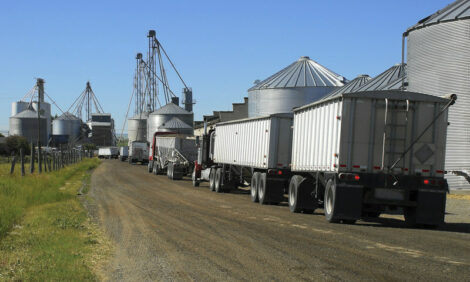



CME: Price:Feed Ratio for Livestock and Poultry
US - CME's Daily Livestock Report for 26th November 2008.Ratios of livestock and poultry prices to the price of corn or
feed have long been used as an indicator of producer profitability
and thus motivations to change output. USDA publishes data for the
two major red meat species, poultry, eggs and milk each month in its Agricultural
Prices publication, released near the end of each month. The
November release will be Friday afternoon and, while we expect it to show
some improvement in the ratios due to lower corn prices, we do not expect
them to be much to shout about given current output prices.
The chart below shows historical monthly observations back to
1984. The November observations are our estimates of what USDA will
publish on Friday. Agricultural Prices is not too specific about the price
series it uses to compute these ratios. We simply used historic prices for
Omaha corn, 5-market fed cattle, national weighted average net hogs, 12-
market broilers and hen turkeys and historic ratios to estimate these. They
are quite logical directionally. We’ll see on Friday just how accurate they
might be.

Ratios for all species except hogs are predicted to improve in
November, driven almost entirely by lower corn prices. That corn price
decline (roughly 10% from October) was not enough to offset seasonally
lower hog prices.
Comparing ratios from recent months to the historic data show
clearly why there has been so much recent consternation about profitability
in the meat protein business.
Chicken:feed ratios were the lowest on record this summer. The
resulting losses have driven the unprecedented reductions in egg sets and
ongoing reduction in the breeder hatchery flock, both of which should contribute
to improvement in the chicken ratio very soon.
Turkey:feed ratios also set record lows this past summer but are
much higher due to strong seasonal influence. That seasonal pattern is
very clear in the historical data.
Hog:corn ratios have been below the 20:1 level that usually symbolized
breeding herd changes since October 2006. They went below 10
this summer for only the second time ever but did not reach record lows;
that distinction still rests with the price debacle of 1998 when the ratio hit
7.5. U.S. producers were relatively slow to respond to ratios less than
20:1, taking about 18 months to reduce the breeding herd below yearearlier
levels. That usually happens in about 12 months — but the breeding
herd usually grows much more than the 1-2% rate we say during 2004-
2006 when the ratio was well above 20.
Fed cattle:corn price ratios have also avoided record lows this
summer but are still far short of profitable levels. The record lows for fed
cattle occurred in 1995-96 when corn prices coincided with large fed cattle
supplies and low prices. It took a long time, but the low cattle:corn ratios
have finally been bid back into lower yearling and calf prices this year.








